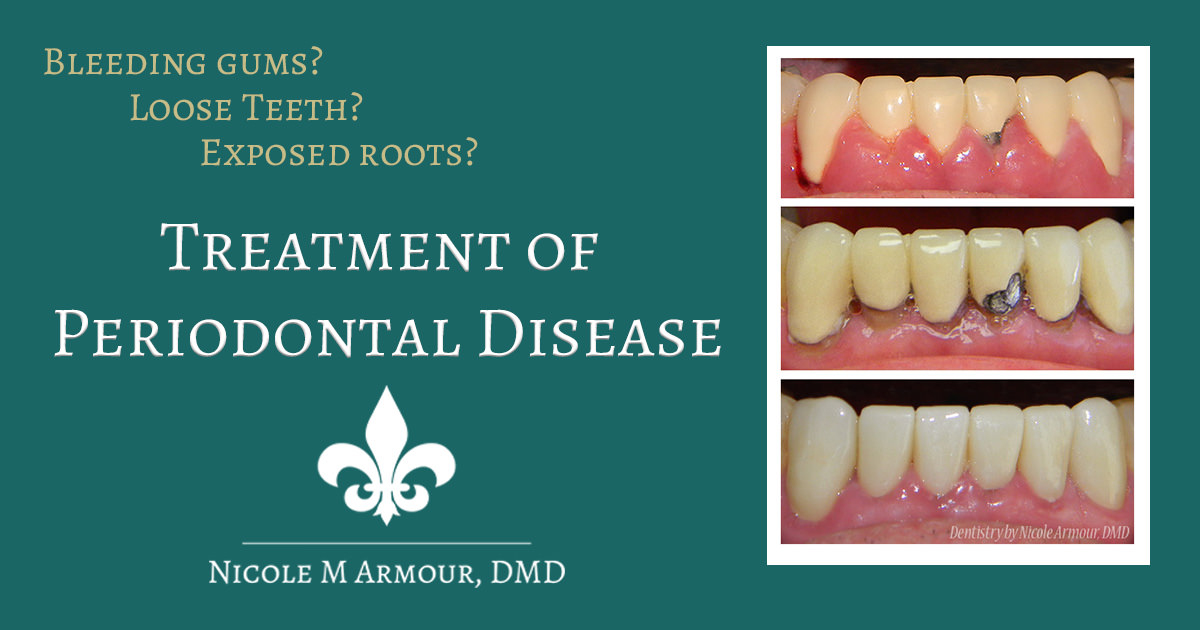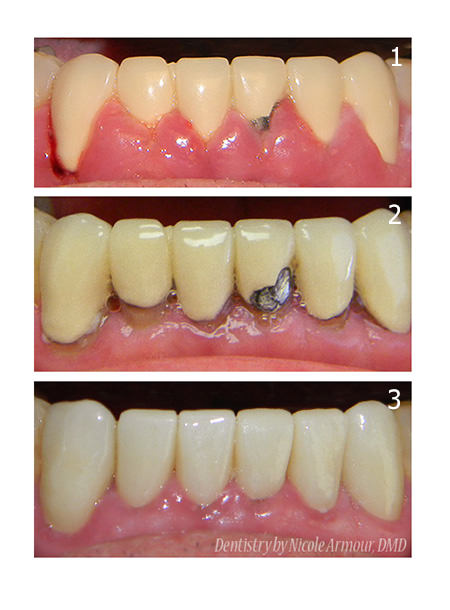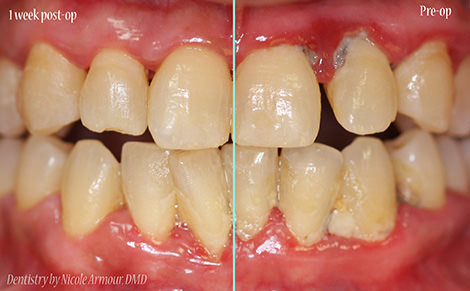Understanding Periodontal Disease - Armour Dentistry of Newtown Blog

Understanding Periodontal Disease
by Nicole M Armour, DMD –
Let’s talk about the less glamorous but very important disease: Periodontitis
Gingivitis and Periodontitis
Treatment of Gum and Bone Disease
Healthy gum tissue attaches firmly to the roots of your teeth. The presence of bacteria embedded within sticky plaque, hard chalky calculus or other foreign materials signals the gum tissue to begin an inflammatory process in an attempt to clear the bacteria. This influx of inflammatory cells creates “inflammation”—the characteristic puffy, red, swollen appearance of the affected tissue. The gums bleed readily and many people worry that brushing and flossing is making their bleeding gums problem worse. We see this frequently in our Newtown, PA Bucks County practice amongst all walks of life: young and old, students and executives, fearless and dental phobic, men and women. Each has individual causes of the disease and requires individualized treatment to control it.

Plaque and Calculus
Early accumulation of bacteria presents as a soft yellow-white “plaque” on the teeth. This sticky film can often be removed by a soft toothbrush. Brushing with a dry tooth brush before using paste can help clear sticky plaque in more refractory cases. If the plaque is present for long enough, calcium will deposit into it and create a hard calcified material seemingly fused with the tooth surface called “calculus”. Brushing and flossing alone cannot remove the firmly embedded calculus. Like barnacles on a boat, calculus requires scaling the surface for removal. Specially angled scalers that either scrape or vibrate the calculus from the teeth are used.
Gingivitis and Periodontitis
When the plaque or calculus is localized to the surface gum tissue only, this disease is known as Gingivitis. A routine dental cleaning performed about every 6 months with improved home care is proper treatment for mild to moderate Gingivitis and for removal of plaque and calculus that is at or above the gum tissue level. Most patients’ oral health is properly maintained on this 6 month regimen. However, with more advanced disease, the calculus deposits can be found under the gum tissue, fixed the tooth roots. This is called Periodontal Disease or Periodontitis. The body tries to clear the bacteria away itself but instead removes alveolar bone that supports teeth in the jaw. If untreated, this periodontal disease will continue to lead to bone loss and eventual loosening and loss of teeth.
How are Gingivitis or Periodontitis diagnosed?
We evaluate the gum and bone health of all patients at each checkup visit. We obtain periodontal charting by using a thin calibrated probe to measure the distance from the top of the gums to the bottom of the pocket where gum tissue attaches to the tooth root. We also document any recession or tooth mobility. Radiographs that show the level of bone relative to the tooth roots are collected and interpreted at indicated intervals.
A healthy gingival pocket is between 1-3 millimeters deep. This indicates the gum tissue is tightly adhered to the root and is more easily cleansable. Even gum tissue with normal pocket measurements may be inflamed if the tissue is puffy, red or is bleeding. This would indicate Gingivitis. A pocket 4 millimeters or more indicates inflammation affecting the surrounding bone and a diagnosis of Periodontitis. Gingivitis and Periodontitis are assessed on a spectrum, categorized by severity, and can be localized or generalized.

Disease Treatment and Management
Scaling and Root Planing Treatment of periodontal disease involves first getting numb so that you can be comfortable during removal of the calculus that has built up under the gum tissue. We use an ultrasonic scaler to vibrate the hard calculus into small pieces that wash away with water into a vacuum suction. The ultrasonic scaler is gentle on the gum tissue. Once the larger pieces are removed we can fine tune the cleaning with specialized hand instruments that hug the tooth and root surface. Patients report no pain during the procedure because they are numb from local anesthetic. The appointment usually lasts 45 minutes.
The procedure is typically performed on the top and bottom of one side of the mouth at a time. You may return to work the same day if you wish but expect to be numb on one side and sore gums after the anesthetic wears off. Taking a little OTC pain medicine before the numbing recedes will help. Some people find that they do not need medicine at all. We keep a close follow-up after the procedure.
Periodontal disease management at Armour Dentistry
We have regularly managed Gingivitis and Periodontal Disease in our Newtown, PA, Bucks County practice. We tailor treatment to each individual patient based on their needs: Busy career? Busy parent? Underlying systemic condition? Medication side effects? Dental product adverse reaction? Incorrect brushing technique? Trouble making a flossing routine? Tooth crowding? Lapse in dental care? Dexterity issues? Special needs?…
We take a realistic approach to individualized treatment by identifying causes of disease, barriers to treatment, and a plan to overcome these issues. Sometimes this requires an element of creativity and even motivation—like looking forward to whitening or Invisalign after we are able to control disease. The extra time we spend getting to know our patients pays off with results. We rarely see relapse and have found that our patients become self-motivated and quickly progress to a sustainable recovery. When roadblocks are hit, we re-evaluate and work through them. In certain cases we involve a periodontal specialist who may provide adjunctive procedures such as Pocket Reduction Surgery or Grafting if indicated.
After completion of Scaling and Root Planing, we recommend a three month interval of cleanings until the disease is under control. In some cases, more advanced disease has caused extensive bone loss requiring more frequent cleanings to prevent tooth loss but, in many cases, we are able to taper off of 3 month intervals to 4 or 6 month intervals. Each recall appointment includes a reassessment of your gingival and periodontal health and continuous fine tuning of your specific treatment course and home care recommendations.
If you are seeking your best oral health, we are committed to working with you for a common goal!
We serve Bucks, Mercer and surrounding counties. Please contact us for an evaluation to plan how we can help you achieve your healthiest smile!
215-860-4141
Upcoming blog posts will focus on Oral Hygiene Tips and Tools, Whitening, Implants, Veneers, Jaw issues and more…
Nicole M Armour, DMD
12 Penns Trail Suite B
Newtown, PA 18940
215-860-4141
